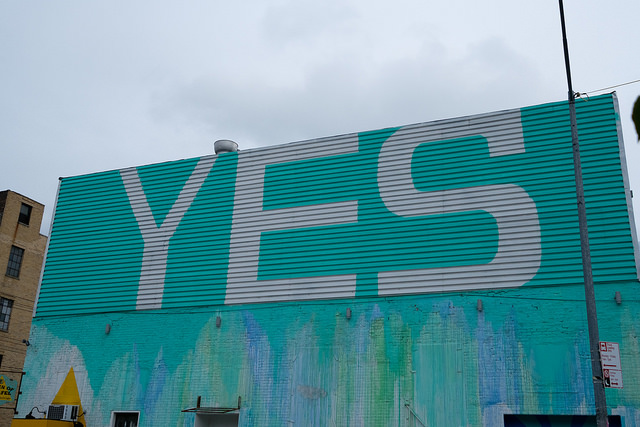
Image Credit: Sean Davis
Note: This week’s post has been written by Jeff Tippett. Jeff is an author, owner of a public affairs + communications firm and professional speaker. He’s an expert on persuasive communications.
Before we look at some strategies to help you position your message for a favorable response, I encourage you to first look inside yourself. How do you approach asking? Are you an asker or a guesser? Let’s talk about both.
Some people are fine with asking questions without regard for the outcome. In other words, they’re fine with asking anything at all and are readily willing to accept no. Other people fall into the guesser category. Those in this category avoid making “the ask” without being pretty certain the answer will be yes. People in this category will often put out feelers to better predict the outcome. These people often ease into the ask, or don’t even have to make it at all. By edging closer and closer to the desired outcome, their audience will often be persuaded through this strategic, indirect approach to persuading.
Have you ever asked someone to marry you? If so, what was your approach? This answer is a huge indicator of your style. For me, when I proposed, I was a guesser. I put out multiple feelers. I tested the water. And, in fact, we ended up planning a wedding without the traditional proposal. And that path worked for us.
Understanding your style will help you best prepare for your “ask.” Like my wedding proposal (or lack thereof), you may end up getting your “yes” without ever asking! Or if you are an “asker,” I suggest you make overly certain you’ve taken all necessary steps before you officially make the “ask.” Now that you better understand how you ask questions, it’s time to think through your strategy of positioning your message. Let’s explore three ways of positioning:
Loss Aversion vs. Prospect Theory
Loss aversion is the theory that contends people prefer to avoid losses more than they do making gains. When positioning your ask, you should consider an approach that suggests what your user will lose instead of what they will gain.
For example, if you put a time limit on a special discount, messaging about losing this discount will most likely catch your users attention and prompt them to act. Or if you message that they will lose access to something, you can also likely prompt users to decide in your favor.
Emotion vs. Logic (fear, hate, anger)
“People don’t buy for logical reasons. They buy for emotional reasons.”– Zig Ziglar
Those of us who process information in a more logical manner often likewise frame our asks logically. And while, for some, that will work, in general, people will tend to gravitate to their emotions in decision-making. Though it admittedly sounds bad, people will often take action based on fear quicker than any other emotion.
We feel before we think.
What happens when you intersect loss aversion with fear? You get a powerful tool to persuade. Consider the 2016 U.S. presidential election. One of the most powerful ads of that political cycle was one produced by the National Rifle Association. This ad was intended to make people fearful of Hillary Clinton, alleging she would take away their guns. The ad was a $5M buy, the NRA’s largest of that cycle. That tells you they were banking on the success of combining loss aversion with fear.
In the 30-second ad, a woman is awakened from her sleep by the sound of glass breaking, and immediately calls 911. The voiceover states: “She’ll call 911. Average response time: 11 minutes. Too late.” Realizing she’s in danger, with no help coming, she reaches for the safe, enters the code, and reaches to remove a handgun. But, all of a sudden, the safe and the gun vanish. The voiceover continues: “She keeps a firearm in this safe for protection. But Hillary Clinton could take away her right to self-defense. And with Supreme Court justices, Hillary can.” With a cut then to the home wrapped in crime scene tape and blue lights piercing the night, the narrator concludes: “Don’t let Hillary leave you protected with nothing but a phone.”
Why was this commercial so effective and worthy of the largest ad buy for the National Rifle Association for that cycle? Fear. And it worked.
Binary vs. non-binary options
Sometimes, we think our ask has to be black and white, yes or no. So, in response, we structure our ask as an all-or-nothing deal. But does it have to be? Or are there multiple potential options that might work? This is your opportunity to be creative; find a way that everyone wins. Expand your own thinking, as to the possibilities.
And while I will agree that often times the decision is a yes or no, I don’t think it always has to be the case, nor should it. If you understand what you want and what your user wants, can’t you find a way that both of you can walk away happy?
On a public affairs campaign I ran, the bill had to be approached in a creative manner. Had we positioned this bill to be a yes or no, it would likely have failed. There were areas of the state that would never be in favor, and so their legislators would have voted against it. And there were areas of the state that were begging for the bill’s success. So, the bill’s sponsors decided to make the adoption within municipalities opt in instead of automatic. That way, legislators representing districts that would not be in favor could vote yes without impacting their own districts. The result? The bill became law. And with very little pushback.
If you’re making a binary ask, it’s important not to back your audience into a corner too soon because it’s really hard to move them out once you’ve boxed them in. Give them lots of flexibility to move and change their viewpoint.
You see, sometimes, we push people to make a decision way too soon. I suggest you give time to receive and process information. Early on, it’s fine to test the waters or see what they are thinking. In fact, it can be very helpful to provide additional, clarifying information as needed. Sharing information in this manner can greatly increase your chances of persuading. However, if you push for an answer too soon, you might get an answer you don’t want. And it’s a lot harder to move someone once a decision has been made. So make it easier on yourself and postpone the ask.
Take these tips and remember them next time you’re writing, speaking, or just having a conversation. They’ll prove useful if you learn to use them.
– Dr. Jim Anderson
Blue Elephant Consulting –
Your Source For Real World Public Speaking Skills™
Question For You: If you don’t think that your speech is generating a favorable response, what should you do?

P.S.: Free subscriptions to The Accidental Communicator Newsletter are now available. Subscribe now: Click Here!
Note: What we talked about are advanced speaking skills. If you are just starting out I highly recommend joining Toastmasters in order to get the benefits of public speaking. Look for a Toastmasters club to join in your home town by visiting the web site www.Toastmasters.org. Toastmasters is dedicated to helping their members to understand the importance of public speaking by developing listening skills and getting presentation tips. Toastmasters is how I got started speaking and it can help you also!
What We’ll Be Talking About Next Time
When you give your next speech, how do you think that your audience will be judging you? It turns out that, not unsurprisingly, a big part of how your audience will be judging you is going to be based on how your voice sounds to them. You may not be aware of it, but as humans, we are wired to have our emotions, memories, and in some cases even thoughts automatically triggered when we hear someone else’s voice. What this means for you as a speaker is that you are going to want to make sure that your audience likes listening to your voice so that they can experience the importance of public speaking. How can you go about making this happen?

